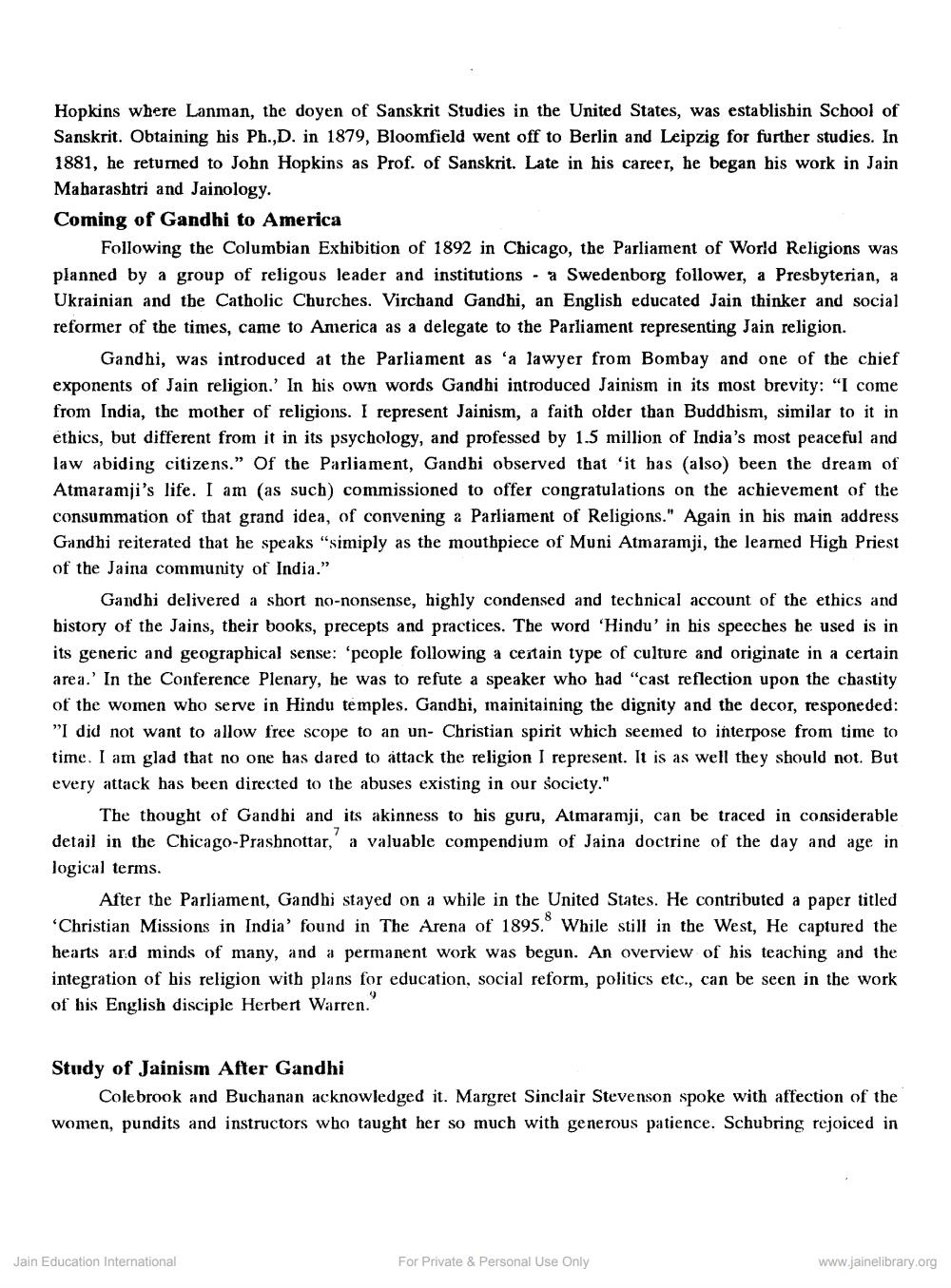________________
Hopkins where Lanman, the doyen of Sanskrit Studies in the United States, was establishin School of Sanskrit. Obtaining his Ph.,D. in 1879, Bloomfield went off to Berlin and Leipzig for further studies. In 1881, he returned to John Hopkins as Prof. of Sanskrit. Late in his career, he began his work in Jain Maharashtri and Jainology. Coming of Gandhi to America
Following the Columbian Exhibition of 1892 in Chicago, the Parliament of World Religions was planned by a group of religous leader and institutions - a Swedenborg follower, a Presbyterian, a Ukrainian and the Catholic Churches. Virchand Gandhi, an English educated Jain thinker and social reformer of the times, came to America as a delegate to the Parliament representing Jain religion.
Gandhi, was introduced at the Parliament as 'a lawyer from Bombay and one of the chief exponents of Jain religion.' In his own words Gandhi introduced Jainism in its most brevity: “I come from India, the mother of religions. I represent Jainism, a faith older than Buddhism, similar to it in ethics, but different from it in its psychology, and professed by 1.5 million of India's most peaceful and law abiding citizens.” Of the Parliament, Gandhi observed that "it has also been the dream of Atmaramji's life. I am (as such) commissioned to offer congratulations on the achievement of the consummation of that grand idea, of convening a Parliament of Religions." Again in his main address Gandhi reiterated that he speaks "simiply as the mouthpiece of Muni Atmaramji, the learned High Priest of the Jaina community of India."
Gandhi delivered a short no-nonsense, highly condensed and technical account of the ethics and bistory of the Jains, their books, precepts and practices. The word 'Hindu' in his speeches he used is in its generic and geographical sense: 'people following a certain type of culture and originate in a certain area. In the Conference Plenary, he was to refute a speaker who had "cast reflection upon the chastity of the women who serve in Hindu temples. Gandhi, mainitaining the dignity and the decor, responeded: ”I did not want to allow free scope to an un- Christian spirit which seemed to interpose from time to time. I am glad that no one has dared to attack the religion I represent. It is as well they should not. But every attack has been directed to the abuses existing in our society."
The thought of Gandhi and its akinness to his guru, Almaramji, can be traced in considerable detail in the Chicago-Prashnottar, a valuable compendium of Jaina doctrine of the day and age in logical terms.
After the Parliament, Gandhi stayed on a while in the United States. He contributed a paper titled 'Christian Missions in India' found in The Arena of 1895. While still in the West, He captured the hearts ard minds of many, and a permanent work was begun. An overview of his teaching and the integration of his religion with plans for education, social reform, politics etc., can be seen in the work of his English disciple Herbert Warren.'
Study of Jainism After Gandhi
Colebrook and Buchanan acknowledged it. Margret Sinclair Stevenson spoke with affection of the women, pundits and instructors who taught her so much with generous patience. Schubring rejoiced in
Jain Education International
For Private & Personal Use Only
www.jainelibrary.org




